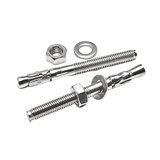They are essential in providing strong and secure connections in environments where regular screws or bolts may not suffice, particularly when working with solid or brittle surfaces.
-
Composition:
- Material: Typically made from steel, stainless steel, or nylon, with various finishes such as zinc plating to enhance corrosion resistance.
- Coatings: Galvanized or plated versions offer protection from rust and corrosion, especially for outdoor or high-moisture environments.
-
Design Features:
- Anchor Body: The anchor expands or creates friction when driven into the base material, offering a secure hold.
- Sleeve or Expansion Mechanism: Some anchor fasteners come with an expansion sleeve that widens when the fastener is inserted, creating a tight grip.
- Threaded Bolt or Screw: Anchor fasteners often feature a threaded section where a bolt or screw is inserted to secure the attached material.
-
Types of Anchor Fasteners:
- Sleeve Anchors: Composed of a threaded bolt inside a metal sleeve. When tightened, the sleeve expands to grip the material, often used in concrete or masonry.
- Wedge Anchors: Feature a threaded bolt and a wedge-shaped end that expands as the bolt is driven into the material, providing a secure hold in solid materials like concrete.
- Drop-In Anchors: A cylindrical anchor designed for solid concrete. The anchor is inserted into a pre-drilled hole, and once set, a bolt is driven into it, causing it to expand.
- Nylon or Plastic Anchors: Commonly used in drywall or plaster, they expand as screws are driven into them, creating a firm hold for lightweight fixtures.
- Toggle Bolts: For use in hollow walls, these fasteners have spring-loaded wings that expand behind the wall when the bolt is tightened, securing the object to the surface.
-
Applications:
- Construction: Frequently used in securing structural components like beams, railings, and brackets to concrete or masonry.
- Mechanical Installations: Used for securing heavy machinery or equipment to floors or walls.
- Electrical Fixtures: Essential for mounting electrical boxes, conduits, or light fixtures on solid surfaces.
- Drywall: Light-duty anchors are used to hang shelves, pictures, or other decorative items on drywall or plaster.
- Plumbing: Often used to secure pipes or brackets to walls in bathrooms, kitchens, or industrial settings.
-
Advantages:
- Strong Hold: Anchor fasteners offer a secure attachment, even in heavy or brittle materials like concrete or brick.
- Variety: Available in various types and sizes, suited to different applications, base materials, and load capacities.
- Versatility: Suitable for both indoor and outdoor applications and for a wide range of materials from drywall to solid concrete.
- Corrosion Resistance: Available in coated and stainless-steel versions to withstand harsh environments.
-
Challenges:
- Pre-Drilling: Most anchor fasteners require a pre-drilled hole to be inserted into the base material.
- Specialized Tools: Some anchors, like wedge or drop-in anchors, may require specific tools for installation.
- Over-Tightening Risk: Tightening the fastener too much can damage the base material or the anchor itself, especially in more brittle substances like drywall or brick.




![Sanding Sheets Abrasives [MSMEs]](/content/images/thumbnails/1078_160_sanding-sheets-abrasives-msmes-_.png)
![Flap Discs Abrasives [MSMEs]](/content/images/thumbnails/1080_160_flap-discs-abrasives-msmes-_.png)
![Sanding Belts Abrasives [MSMEs]](/content/images/thumbnails/1081_160_sanding-belts-abrasives-msmes-_.png)
0 Comment
Leave a Comment